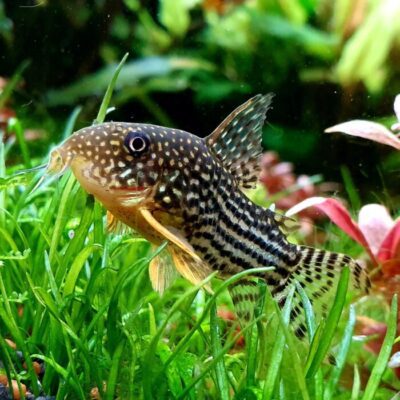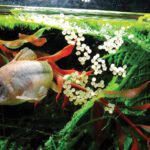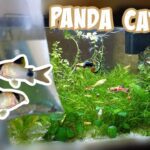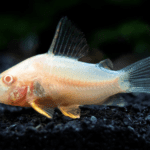Corydoras, also known as cory cats, are a genus of small, bottom-dwelling catfish that originate from South America. With their armored bodies and energetic personalities, corydoras have become extremely popular aquarium fish. They are generally peaceful, get along well with other community fish, and help clean up uneaten food and debris in the tank. To keep your cory cats healthy and thriving, it’s essential to create an ideal tank environment that resembles their natural habitat. In this article we talk about Creating the Ideal Environment for Corydoras Catfish In 2024.
Table of Contents
Tank Size
Most corydoras species max out at 2-3 inches in length. A standard 10 gallon aquarium provides adequate room for a small group of 6 corydoras with adequate swimming space. For larger schools of corydoras, aim for a 20 gallon or bigger tank. The additional space allows them to exhibit their natural shoaling behavior. Avoid overcrowding as high bioloads can deteriorate water quality.
Substrate
In the wild, corydoras forage for food among the sandy bottoms of slow-moving streams, rivers and pools. Recreate this environment at home by using a smooth, fine-grain sand substrate no larger than 1-2mm in diameter. Smooth gravel around 3-5mm in size also works well. Larger gravel with sharp edges may damage sensitive barbels around their mouths. Bare bottom tanks are not recommended as corydoras need substrate to exhibit natural behaviors.
Plants and Décor
Corydoras appreciate having plenty of hiding spots created by driftwood, rock caves and aquatic plants. Provide an assortment of broad, smooth-leaf plants such as Java fern, Amazon sword and crypts for ample shade and resting areas. Floating plants like hornwort and anacharis help diffuse bright lighting while providing supplemental food sources. Arrange decorations and plants along the bottom to create natural territories and boundaries. Leave plenty of open swimming areas so they don’t feel trapped or confined.
Water Conditions
In the wild, corydoras inhabit very soft, acidic fresh waters with parameters close to:
- Temperature: 72°F – 79°F
- pH: 6.0 – 7.0
- Water Hardness: 2 – 10 dGH Recreate their natural conditions as closely as possible in the home aquarium. Aim for moderately soft water with a neutral pH around 6.8. Water temperature between 72-78° F provides an ideal range. Invest in a liquid test kit to routinely monitor ammonia, nitrite, nitrate and pH. Through partial water changes, maintain nitrate levels below 20 ppm and ammonia/nitrites at 0 ppm.
Filtration
Corydoras have a relatively light bioload compared to other fish. A standard HOB or canister filter appropriately sized for the tank volume provides sufficient mechanical and biological filtration. Ensure water flow isn’t too turbulent. Corydoras prefer low flow environments. Strategically position filter outflows to minimize disruption along the bottom. Supplement with air stones and powerheads to improve surface agitation and oxygen circulation.
Feeding Corydoras
In nature, corydoras forage along substrate for insect larvae, worms, crustaceans and plant matter. In the home aquarium, they should be fed a varied, protein-rich omnivorous diet. Offer a rotating mix of foods including:
- Sinking catfish pellets and granules
- Frozen or freeze-dried bloodworms, brine shrimp, daphnia
- Blanched vegetables like zucchini, cucumber, spinach
- Algae wafers and spirulina pellets
Feed small portions 2-3 times daily. Watch that foods get consumed within 2 minutes to prevent waste buildup. Supplement their diet with natural grazing on aufwuchs, biofilm and microorganisms coating surfaces within the tank.
Tank Mates
Peaceful community fish make the best tank mates for cory cats including:
- Small tetras like ember tetras, neon tetras, rummynose tetras
- Rasboras such as harlequin rasboras, lambchop rasboras
- Peaceful barbs like cherry barbs, gold barbs
- Danios, white cloud mountain minnows, hatchetfish
- Dwarf gouramis, honey gouramis, sparkling gouramis
- Bristlenose plecos, otocinclus
Avoid pairing corydoras with aggressive species prone to nip fins like tiger barbs, convict cichlids and Jack Dempseys. Shrimp and snails also make excellent clean-up crew additions.
Groups of 6+
In nature, corydoras congregate together in large shoals. To exhibit natural behaviors in captivity they should be kept in groups of at least 6 or more of the same species. Mixing cory species is not recommended as they may hybridize. Some popular beginner-friendly cory species well-suited to community tanks include:
- Bronze Corydoras: hardy, max 2 inches
- Panda Corydoras: black and white coloration, max 2 inches
- Julii Corydoras: leopard print pattern, max 3 inches
- Peppered Corydoras: black and white speckles, max 2.5 inches
- Sterbai Corydoras: zebra stripe pattern, max 2.5 inches
Provide the recommended group sizes and tank conditions outlined above and your corydoras will thrive for years to come, exhibiting their energetic, fascinating behaviors! Their frequent activity along the tank bottom and endearing personalities make corydoras one of the most popular catfish for community aquariums. I sincerely hope you find this “Creating the Ideal Environment for Corydoras Catfish In 2024” article helpful.
🔱 More From CoryCatFish






